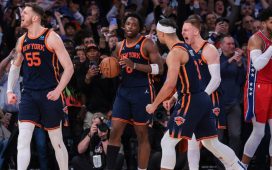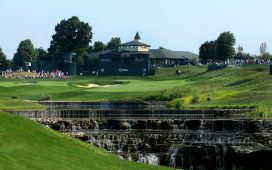(Editor’s note: After the upcoming U.S. Open at Torrey Pines, there are no municipal golf courses on the majors schedule for the foreseeable future. In a three-part series, Golfweek sheds a spotlight on municipal golf, why it’s a crucial piece of the golf industry and how it’s evolving.)
AUSTIN, Texas — Hop along the hills on Enfield Road — which bounces from the vibrant downtown scene here to a quaint neighborhood on the west side near Lake Austin — and an endless stream of single-family homes and condos is breached by a long row of tall Texas oaks.
For those heading to a popular strip of shops and restaurants along the lake, it’s an insignificant stretch. But for those who preceded the Austin boom, this is sacred space, a revered golf course in a now-gentrified neighborhood. A green respite amid the chaos.
On the backside of those trees is Lions Municipal Golf Course, built in 1924 and still considered one of the best places to play golf in a now-thriving metropolitan area. It’s not uncommon to see celebrities here. Matthew McConaughey is often spotted with his son. Sergio Garcia has been known to sharpen his game here. Rich Beem is a part-time Austin resident and will pop in from time to time. Former University of Texas football coach Mack Brown was known to frequent the course, often accompanied by some of his players.
And on this spring morning, as is often the case, Ben Crenshaw is roaming the grounds at Lions, which locals simply refer to as “Muny.” With an impressive list of world-renowned courses on his architectural resume, not to mention the ability as a 19-time PGA Tour title winner and two-time Masters champ to finagle his way onto almost any track, Crenshaw still forgoes bigger name sites to play his boyhood 18 whenever possible.

Ben Crenshaw discusses a plan to save Austin’s Lions Municipal Golf Course. (Austin American-Statesman photo)
A thoughtful soul, Crenshaw gets an extra dose of sincerity as he talks about Muny, and it’s easy to see why. He’s stopped on this morning near the practice green by a friend with whom he played Little League baseball. The superintendent pops by to ask a question or two. And lifelong pal Scotty Sayers, his agent since 1985 and a founding partner in his Coore and Crenshaw design firm, is by his side.
“I was introduced to this place at a really early age, like 8 or 9 years old. It was so convenient that we just came here, and we learned that everybody came here, from all walks of life. The community always embraced this place and it’s got a long legacy, a really long legacy. It’s been a fixture, really,” Crenshaw said. “And it’s beautiful. It’s open and it’s inviting and it’s a place to meet people you know, just like any other municipal golf course in the country.
“You can see the joy that it gives to people. It lasts, as we know. If you start young, you’re really fortunate because you carry it — golf and a place like this — with you for the rest of your life.”
Crenshaw and Sayers developed their love for the game at Muny, and they’re desperately trying to give future generations an opportunity to do the same. Real estate in many parts of the country is a booming business and Austin is no exception. In fact, the metro area has dipped in recent “best places to live” polls as housing increasingly becomes more expensive.
This, of course, has made the 141 acres on which Muny sits extremely valuable. The City of Austin is conducting virtual stakeholder meetings the week of June 21, asking for public input on zoning for the area, and Crenshaw and Sayers are putting together a trust to hopefully purchase the area for a reasonable price and preserve it for years to come.
The land is part of the 500 acres of University of Texas-owned land known as the Brackenridge Tract, and is considered the first integrated golf course in the south. The city has leased 140 acres for Muny since 1936 and currently pays UT about $500,000 a year. If the parties don’t come to an understanding, the university could be free to lease the property to another entity, develop it or sell it.
Similar scenarios, although perhaps not always as entangled, are playing out throughout the country at municipal golf courses.

Crenshaw and others are fighting to preserve the 141-acre golf course. (Photo by Jay Janner/Austin American-Statesman/USA Today Network)
The distinction: Municipal vs. public golf
To understand what municipal golf is and why it matters, you must first comb through the proper definition. A handful of the courses listed on the Golfweek’s Best Course You Can Play list are municipal, but many are not.
There’s a reason this is an important distinction. Public, non-municipal golf facilities were created as for-profit endeavors. Many of the residential golf courses built during the early ‘90s golf building boom fall into this category. These were not built to grow the game, per se, but rather to capitalize on the game’s popularity. It’s sound business — as golf’s numbers grew, especially during the beginning of Tiger Woods’ ascension, courses were built to take advantage of the uptick in rounds played.
A municipal course, on the other hand, is one that occupies publicly owned or municipal land. Why is this important? As the business of golf waxes and wanes, municipal courses are expected to fulfill multiple purposes:
• To maintain greenspaces in urban areas
• To provide recreational opportunities for residents
• And perhaps most important, to introduce new players to the game
• (They are also hoped to be at least financially self-sustaining)
Sure, it’s fun for average duffers to dream about an afternoon at Pebble Beach, Pinehurst or Bandon Dunes, but new players don’t typically evolve into lifelong consumers at the top of the funnel. The game needs to be — and here’s a phrase we’ll repeat often in this series — accessible to the masses.
“At its core, golf is not about manicured greens or high-end amenities. It’s about how golfers experience the game. Players experience the game in a multitude of ways, whether it’s at municipal golf courses or high-end clubs,” said Sinclair Eaddy Jr., a former president and executive director of the First Tee of Greater Baltimore who now serves as the executive director for the National Links Trust. “But what’s important is the experience the golfer has when they’re on the course. That’s an intangible thing and it’s something you just can’t put a value on.
“Good golf, compelling golf, should be affordable for all golfers.”
According to the National Golf Foundation, there are about 2,500 municipal golf courses throughout the country, and while the pandemic has served as a kickstart for the entire golf industry — with the sport naturally promoting social distancing and healthy recreation — some of these courses continue to slip away, even with increased demand. Nearly 200 18-hole equivalent closures took place in 2020, or about 1.3% of the total supply.
Those sites that are shuddered often exacerbate the issue of keeping golf accessible to the masses. (Yes, there’s that phrase again.)
Case study: Dayton (losing at-risk players)

Madden Golf Course in Dayton, Ohio, was permanently closed in 2020. (Contributed photo)
For example, the city of Dayton had three municipal golf facilities at the start of 2020: Community Golf Course, Madden Golf Course and Kittyhawk Golf Center. Although the three-facility system was self-sufficient as a whole, Madden — which was built in 1929 and sits just a few miles from downtown Dayton — always lagged financially.
The historic course played host to PGA Tour pros Lee Elder, Jim Dent and Charlie Sifford through the years.
“We made enough money on the other two golf facilities in our group to cover the losses at Madden,” said Kelly Pressel, the City of Dayton’s manager of the division of golf. “But when we were going to have to start covering the costs from our city’s general fund, the decision was made to close the facility.”
As Kittyhawk, which had three 18-hole tracks, started to fall into a similar financial boat as Madden, the system collapsed. An NGF study suggested that outdated irrigation systems and insufficient clubhouse facilities were dragging Kittyhawk and Madden down. An investment of about $9 million was suggested.
But when the pandemic took hold early in 2020 — before the golf season started — and an 18 percent general fund shortfall was predicted, the city decided to close both Kittyhawk and Madden.
The closures, while financially sound for the city, could have devastating effects on any attempt to build the area’s golf base. The revenue from Community provided about half of the golf department’s total budget line and according to the NGF study, it’s in a “golfer-rich” area. While that means Community will likely be able to stand on its own on the ledger sheet, opportunities for minority and inner-city players — those the USGA and PGA of America are trying hard to woo — will likely dwindle.
Former Dayton mayor Clay Dixon told the Dayton Daily News the loss was significant for the Madden community, one with which he was tightly associated.
“It was more than just a golf course. It’s a venue with a lot of history to African-Americans,” Dixon said. “We had to fight to be able to play there. It became part of the fabric of our community. You can’t judge that just in terms of dollars and cents.”
‘We don’t want this to be a country club.’

Ben Crenshaw reads a Golfweek article about a course in Palm Beach, Florida, that’s working with the PGA of America. Crenshaw is working to save Austin Lions Municipal Golf Course, the course he started playing as a kid. (Tim Schmitt/Golfweek)
While the issues in Dayton are very different than those facing Crenshaw and Sayers in Texas, the results could be similar. Currently, the city of Austin’s junior golf academy is on-site at Lions and due to a lack of similar facilities, would likely need to be moved out of the city if the course were to close. Austin only has a handful of other public golf options near downtown.
But if Crenshaw and Sayers have their way, a conservancy they helped to form will purchase Muny from the university and allow play to continue as it has for decades.
“We’d like to make it more like a course in Scotland in the center of town,” said Sayers. “We’d like to make more public areas — maybe a bigger putting green where kids that aren’t part of the Austin Golf Academy can just come knock the ball around. Or families can come out and have a reasonably priced meal and hang out, even if they’re not playing golf on the course.
“It really is like a community center, that’s what you feel when you come here. You feel like everybody is comfortable here, not pretentious. All economic backgrounds, all races. We don’t want this to be a country club.”
Crenshaw isn’t the only big name to come through the doors at Lions — Ben Hogan, Tom Kite, Byron Nelson and 42-time LPGA winner Sandra Haynie have all been regulars at one time or another.
And as he talks about the history of the course, he does so while sitting next to an office named for Tom Penick, a head pro at Lions from 1927 to 1961 often credited with helping in its design. Penick’s younger brother, Harvey, turned out to be a pretty coach in his own right.
“This place,” Crenshaw said while motioning the booming city in the distance, “has exploded. It’s not going to stop. There’s no stopping this town. But I think people have seen the benefit of the preservation of greenspace now. I mean that comes before a lot of things and it’s rapidly disappearing every day.
“People need a place like this. And we want to make sure it doesn’t go away.”
COMING MONDAY: Many municipal courses are now managed by outside companies. Why? Does it work well? And what are the financial hurdles municipal courses need to overcome to be viable?








